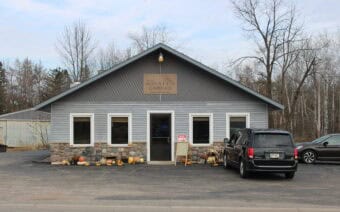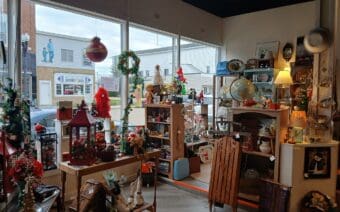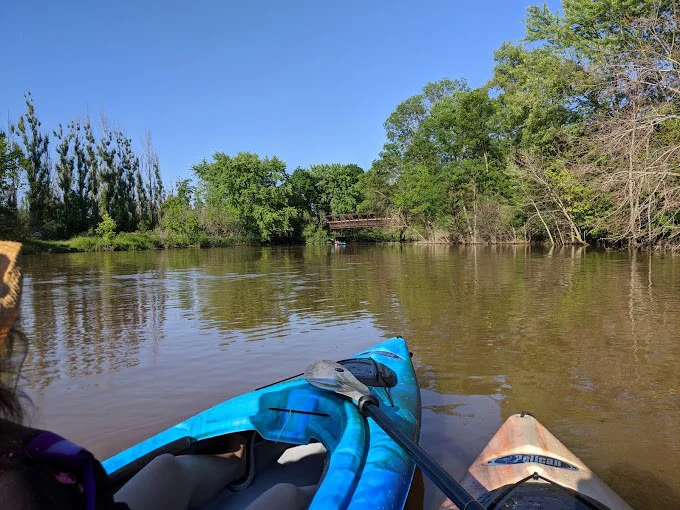
August 9, 2023
ALLOUEZ – Nestled between Green Bay on the north and De Pere on the south, and surrounded by both the Fox and East rivers, the Village of Allouez has a long Northeast Wisconsin history.
Developed 150 years ago as a suburb of Green Bay, Allouez is primarily a residential community with a population of just more than 14,000 people.
It has no defined downtown, nor any industrial park.
“In fact, we don’t have any businesses that even fall under the industrial category,” Village Administrator Brad Lange said. “We have more medical-related businesses, such as healthcare clinics, and Bellin Health has some central offices here, such as its IT and human resources (operations). They have two large buildings they occupy for that.”
In addition, the village is home to an architectural and engineering firm, chiropractic care, some restaurants and banks, among other small businesses.
But don’t let the lack of “big business” fool you though, Trevor Fuller, director of community development and planning, said, Allouez – a community celebrating its sesquicentennial this year – is unique in its own way.
“We’re fortunate we’re a small community in a larger metro area,” Fuller said. “I think we have everything someone would need to live in the village, but yet have access to all that other bigger market stuff, too.”
Centrally located within Brown County, with major highways and interstates nearby, Allouez is approximately seven minutes each to downtown Green Bay and downtown De Pere, 10 minutes to Lambeau Field (home of the Green Bay Packers), 10 minutes to Green Bay’s Austin Straubel International Airport and 15-20 minutes to the University of Wisconsin-Green Bay.
While many communities – small and large – use Tax Increment Financing districts (TIF or TID) as a primary means of attracting new development, Lange said Allouez only has one TIF district, which was created in 2012 and is the only one the village has ever had.
“It encompasses part of Riverside Drive and Webster Avenue,” he said. “We’ve had some success in that district with some in-fill development with some businesses that have gone in there. The way we approached it was we did a corridor study in 2016 and engaged the community within that study to try to find what our residents were interested in seeing as development in the community, primarily (in that TIF district).”
So far, Lange said the village has been able to build some of those things.
“Of course, there’s more to do, but having that community engagement was critical for us,” he said.
One of the things residents wanted, Lange said, was a brewery.
Zambaldi Beer opened on Webster Avenue in 2021.
Lange said a daycare provider is now available as well after residents said that was an important thing for the village to have.
Village mostly developed, land-locked
Lange said there aren’t a lot of other places available for commercial development in the village.
“We’re roughly 97% developed, so there’s not a lot of opportunities left in the community to build,” he said. “For example, I think our last subdivision went (up around) 2010 and the chances of another subdivision happening are unlikely.”
Fuller said now, much of what the village is focusing on is “in-fill, mixed-use development primarily along Webster Avenue and Riverside Drive – two of the three main thoroughfares through the village.”
“(These include) different home types, mostly condos and apartments above, and commercial (development) on the ground floor,” he said. “Webster feeds directly to two of the main area hospitals in Green Bay. So, there’s a little more commercial and medical development there. Riverside runs parallel with the Fox River, so there’s good opportunity there, as well.”
Due to the village’s physical location, it is land-locked, which Lange said makes in-fill even more important, especially in places that may be underutilized or vacant.
“The areas along Webster and Riverside are already established commercial areas, but we want to preserve the historic residential character of some of the neighborhoods, as well,” he said. “It’s a balancing act. We need development to grow and to increase our tax base, but we also want to preserve what we currently have.”
Historic preservation important to village
Lange said historic preservation efforts within the village started in 2010.
Since then, the village has been able to get two residential neighborhoods on the national historic registry and is working on a third.
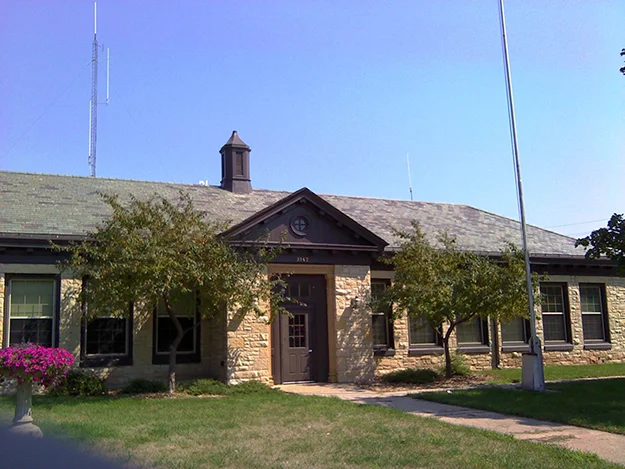
The village has two buildings on the National Registry – including this former water pump station on Webster Avenue. Submitted Photo
The village also has two buildings on the registry.
Both buildings, Lange said, are former water pump housing or water utility buildings.
One, he said, has been repurposed into a realtor’s office, while the other is now a three-unit apartment building.
Lange said the village has re-purposed other existing buildings as well, including a former bank building that closed several years ago that is now home to Discovery Health Healing Center (1601 S. Webster Ave.).
“It fits well within the corridor, especially being so close to the other medical facilities,” he said. “The hospitals are literally within a half mile to three-quarters of a mile from our border.”
Residents want different housing options
Fuller said the corridor study also showed people wanted different housing types.
As a suburban community, he said Allouez has many single-family units, but few apartments and condos.
“While we still have a strong desire to have single-family homes, we also have people who have lived in those single-family homes for maybe 30 or 40 years, who raised their families and are now empty-nesters and no longer need that kind of space,” Fuller said. “They want to stay in Allouez – so those folks want apartments or condos.”
Fuller said there are also people who grew up in Allouez, went away to college and are now looking to relocate back to the village but are not yet ready for a house.
“Those are some of the reasons we’ve been focusing on these mixed-use projects because they provide that commercial space, but also the different housing opportunities for people to relocate into,” he said.
Potential tax-generating property
Lange said there is one large area of land on which the village could develop – if the state would close the Green Bay Correctional Institute that currently occupies it.
For several years, village and some state officials have been pushing for the facility to be decommissioned and closed, citing many incidents in which officers were injured by inmates; a facility that is too expensive to run and too old to operate efficiently; and it is tax-exempt and costs the village money every year – just to name some.
“To the best of my knowledge, it’s the most expensive prison in the State of Wisconsin to run,” Lange said. “Because it was built more than 125 years ago, it is not designed to today’s standards that would make it more efficient.”
Lange said it sits on 50-60 acres of land that is currently tax-exempt and “is right smack in the middle of the community that otherwise would allow a tremendous economic opportunity for the village.”
In addition to its size, Lange said the prison sits directly on the corridors of Webster Avenue, Riverside Drive and Highway 172 – running all the way down to the Fox River.
If torn down, he said, the land could be used for tax-generating business.
Lange said an architect who has prepared master plans for communities all over the world, and who is an Allouez resident, has developed a conceptual plan of what could be done with the land if the prison was decommissioned.
Among the ideas presented in his plan, includes:
The creation of a riverfront destinationIncreased tax base for the entire countyJob creation, increased economic activity and $80 million or more in new developmentEconomic contribution to the Village of AllouezEnhanced village aesthetics
“There are some historic buildings on the land which would be ideal to highlight and re-purpose,” Lange said. “The conceptual plan is a great example of how we could repurpose a state facility into something spectacular.”
Expanding trail systems
Two of the main regional recreational, non-motorized trails run through Allouez – the East River Trail and the Fox River Trail, which is the busiest state trail in Wisconsin.
Lange said the village has focused efforts as of late toward expanding the trail system to make part of the East River area a water trail, as well as creating points of interest along it.
Stretching from north of Allouez and continuing south to Hilbert, the Fox River Trail is about 50 miles in length.
“We’re a ways out before this is going to (become reality), but we’re working on plans now for having access to the river for people kayaking or canoeing,” Lange said. “If you get on the East River, suddenly you feel like you’re up north because it is so heavily wooded. It’s very scenic. So, we’re looking at providing alternative recreational opportunities for people on a beautiful waterway that has been underutilized.”
That water trail, Lange said, would incorporate the area from Green Bay down to Ledgeview, which is a 13-plus-mile paddle route, one way.
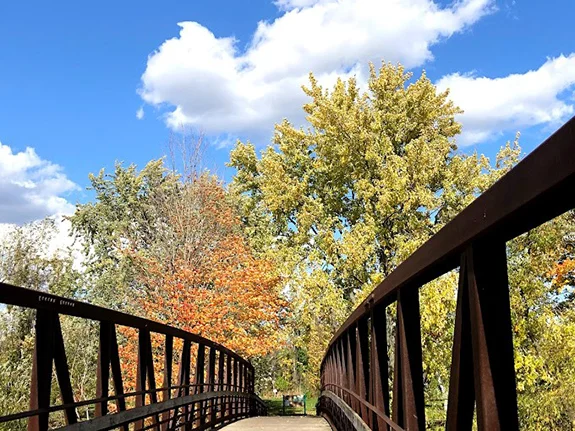
Two of the main regional recreational, non-motorized trails run through Allouez – the East River Trail and the Fox River Trail. Submitted Photo
But the village would need to provide access to the river so people can get to it, such as launches.
“We’re working on identifying key areas within that whole stretch where we could have launches that would be both accessible for everyone,” he said. “We’re also looking at identifying points of interest along the river. It would also include those places where someone could pull their canoe or kayak out of the water and wander around those points of interest – whether that be exploring a park along the way, stopping at a restaurant, and so forth.”
Other steps to make this a reality, Lange said, are stream bank stabilization and invasive species removal, as well as removing other downfalls along the river that would create obstacles for people.
“While doing those things, we’re also improving wildlife habitat for both aquatic species and migratory birds,” he said, adding they plan to start removing some of the invasive species this winter. “By next August, we’re hoping to have one or two more launches put in. We’ll also be replanting pollinator plants in the area and doing stream bank stabilization, along with reforestation in some areas.”
Lange said residents have also expressed a desire for more gathering places, so the village is working toward creating a more defined Main Street or community- or city-center.
Village parks
Where the village may lack industrial property, it makes up for in park acreage.
At 51 acres, Lange said Green Isle Park hosts a lot of community events year-round, including car shows, concerts, youth sports and a pop-up dog park.
Heritage Hill State Historical Park houses on its 54 acres, 26 original and reconstructed buildings representing historical and cultural developments related to northeastern Wisconsin from the 1600s to today.
Among them are Fort Howard, the first courthouse in the state, the first village town hall, an old chapel and some of the area’s first trader homes.
Another park Lange said the village is extremely proud of is Optimist Park, which is where the Miracle League holds its annual event.
Founded in 2006, the Allouez Optimists Miracle League of Green Bay provides kids with mental and/or physical challenges, aged 4 to 19, an opportunity to play baseball as a team member, with real uniforms, in an organized league, regardless of their capabilities.
As the league has grown, Lange said millions of dollars of improvements have been made to the field, which has included donations from Brett and Deanna Favre and Dick Resch, as well as other individuals and corporations.
Though the village is turning 150 years old, Lange said village leaders aren’t resting on their laurels.
Instead, he said they are looking ahead with optimism to the next 150 years.
 U.S. Women’s Disc Golf Championship coming to Manitowoc County
U.S. Women’s Disc Golf Championship coming to Manitowoc County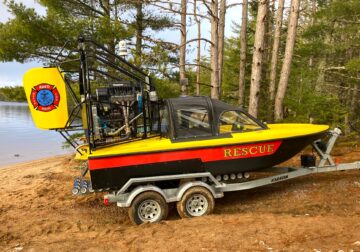 1000 Island Airboats named Coolest Thing Made in Wisconsin
1000 Island Airboats named Coolest Thing Made in Wisconsin







